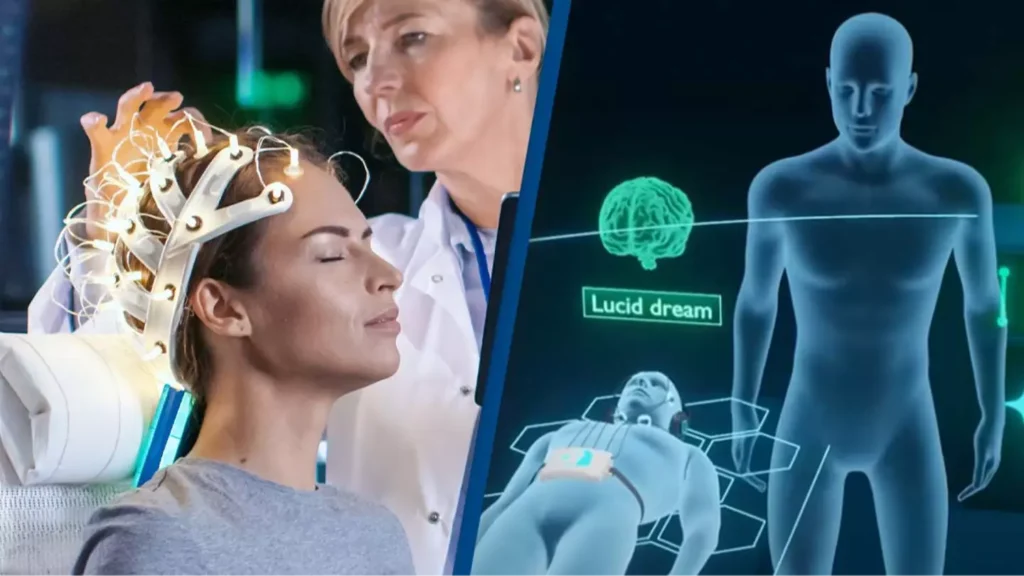Imagine a world where dreams are no longer solitary, fleeting experiences but a shared space where thoughts can be exchanged with another person.
For centuries, the idea of communicating within dreams has been relegated to the realms of myth and science fiction, a concept explored in surreal tales but never considered achievable—until now.
Scientists have made a groundbreaking leap by enabling two individuals to exchange signals while asleep, marking a monumental step in decoding the subconscious. This discovery has sparked both excitement and controversy, raising profound questions about the nature of human consciousness and the ethical boundaries of technology.
Are we witnessing the dawn of a new era in neuroscience, or are we venturing into uncharted ethical territory? As debates unfold across social media and scientific communities, one thing is certain: our understanding of dreams—and their potential—is about to transform.
The Science Behind Dream Communication
Dreams have long been viewed as private, intangible experiences, with no clear way to share them with others. However, recent advancements in neuroscience have challenged this notion, suggesting that human communication within dreams may no longer be confined to science fiction.
Researchers have now demonstrated that two individuals can exchange signals while asleep, proving that direct interaction in the dream state is possible. This breakthrough was achieved by combining two key elements: lucid dreaming and brainwave monitoring.
By meticulously tracking sleep patterns and using external stimuli, scientists established a form of dream communication that could redefine our understanding of consciousness and the human mind.
At the core of this discovery is lucid dreaming, a phenomenon where individuals become aware that they are dreaming while remaining asleep. Lucid dreaming is rare and requires practice, as most people do not realize they are dreaming until they wake up.
In this study, participants underwent training to enhance their ability to recognize when they were in a dream. Techniques such as reality checks, dream journaling, and pre-sleep visualization exercises were employed to help them maintain awareness during their dreams. Once in a lucid state, participants were instructed to interact with external cues while staying within the dream.
The second critical component of the study was brainwave monitoring, which allowed researchers to track participants’ sleep cycles in real time. Using electroencephalography (EEG), a technology that records electrical activity in the brain, scientists identified when individuals entered the rapid eye movement (REM) phase of sleep, the stage most associated with vivid dreaming.
Precise timing was essential, as it ensured that communication attempts were made while participants were actively dreaming. During this phase, researchers introduced external stimuli, such as light flashes or sound cues, to test whether these signals could be perceived and responded to within the dream world.
To establish clear communication, participants agreed on prearranged signals before falling asleep. For example, one person might send a message by moving their eyes in a specific pattern, while the other would acknowledge receipt with a different movement.
These responses were monitored using EEG and eye-tracking technology, confirming that intentional communication was occurring. The results showed that dreamers could recognize and respond to external stimuli without waking up, providing the first documented evidence of two-way interaction within a dream.
While the exchanges were simple, they demonstrated that the human brain is capable of processing information and producing meaningful responses while asleep. This groundbreaking discovery suggests that dreams may not be as isolated as previously believed and that communication through the subconscious could become a reality.
Implications and Future of Dream Communication
This experiment’s success opens up a wealth of possibilities for neuroscience, psychology, and human interaction. If dream communication can be refined and controlled, it could revolutionize fields such as therapy, memory research, and even collaboration.
One of the most promising applications lies in mental health. For individuals struggling with trauma, anxiety, or other psychological conditions, dream communication could offer a new form of therapy. Lucid dreaming is already being explored as a way for patients to confront and process their fears in a safe, controlled environment.
The ability to communicate with a therapist or guide within a dream could enhance this approach, allowing for real-time intervention and support while the person remains in their subconscious state.
Beyond therapy, dream communication could also play a significant role in cognitive enhancement and learning. Scientists have long studied the connection between dreaming and memory consolidation, with research suggesting that sleep is crucial for processing and storing information.
If individuals could consciously interact with their dreams, it might be possible to reinforce learning, practice new skills, or solve complex problems while asleep. Some researchers speculate that dream-based interactions could be used for collaborative brainstorming, where individuals communicate in the dream world to generate creative ideas or solutions.
While still theoretical, this concept hints at a future where sleep is not just a passive state of rest but an active space for innovation and development.
However, despite its exciting potential, dream communication also raises significant ethical and practical concerns. One major issue is privacy and consent. If technology advances to the point where dream messages can be sent and received at will, safeguards must be in place to prevent unauthorized intrusion into a person’s subconscious.
The idea of external influences shaping dreams without the dreamer’s consent poses serious ethical dilemmas, particularly in areas like advertising, behavioral conditioning, or even surveillance. Researchers must ensure that future developments prioritize ethical considerations and personal autonomy.
Another challenge lies in the reliability and accessibility of the technique. Lucid dreaming is not a skill everyone can master, and it requires dedicated training. If dream communication depends on a person’s ability to become lucid, it may remain limited to a small group rather than becoming a widespread tool.
Additionally, while the study demonstrated simple interactions between dreamers, it is still unclear whether more complex messages or sustained conversations can occur within the dream state. Further research is needed to refine the process, improve response accuracy, and explore ways to expand the method beyond trained lucid dreamers.
Looking ahead, advancements in neuroscience and technology may help overcome these limitations. Improved brainwave monitoring tools, such as high-resolution EEG devices and brain-computer interfaces, could allow for more precise tracking of dream states and responses.
Some scientists speculate that artificial intelligence and machine learning could be integrated into dream research, helping decode brain activity and translating dream signals into more complex forms of communication. If successful, this could lead to a future where individuals can intentionally interact with others in a shared dream environment, blurring the line between the conscious and subconscious worlds.
Public Reactions to Dream Communication
The revelation of successful communication between two individuals during lucid dreaming has sparked widespread debate. While some hail it as a groundbreaking leap in neuroscience, others question its validity and ethical implications.
On platforms like Reddit, skepticism has emerged, with users questioning the practicality of the technology. For instance, one user asked, “What is it in this setup that can’t be done while awake?” Meanwhile, others see immense potential, with comments like, “Just imagine the possibilities… you’d be able to absorb information even when you’re sleeping.”
On X (formerly Twitter), Michael Raduga, founder of REMspace, announced the breakthrough, prompting both excitement and concern. Some users, like @sthottempudi, called it a “very interesting technology development,” while @romairfan questioned, “So how will this hurt the people?” Others, like @TKEyVsEarth, speculated on the risks of dream control, imagining a future where people become addicted to designing their dream experiences.
REMspace achieved the first-ever communication in dreams. We have already succeeded twice (on September 24th and October 8th, 2024). More details soon pic.twitter.com/piM1wmWltY— Michael Raduga (@MichaelRaduga) October 8, 2024
On Twitter, the conversation has been equally polarized. Some users express excitement about the therapeutic and educational applications, while others raise concerns about privacy and the potential for misuse. These reactions highlight both the promise and the ethical dilemmas of dream communication.
While the technology could revolutionize therapy, learning, and personal development, concerns about manipulation, privacy, and psychological effects remain. As research advances, balancing innovation with ethical responsibility will be crucial in navigating this uncharted frontier.
The Future of Dream Communication
The first successful communication between two individuals in a dream marks a turning point in our understanding of the mind. What was once thought to be an isolated and personal experience is now proving to be an interactive space with untapped potential.
This breakthrough raises profound possibilities for therapy, cognitive research, and even new forms of human connection. If dreams can become a medium for learning, problem-solving, and emotional healing, we may be on the verge of redefining the role of sleep itself.
However, with such progress comes uncertainty. The ethical and psychological implications of dream communication remain largely unexplored. Can this technology be controlled responsibly, or does it open the door to unintended consequences, such as subconscious manipulation or over-reliance on dream experiences?
Skeptics argue that the complexity of the human mind cannot be reduced to signals exchanged in REM sleep, while others worry about privacy concerns in an era where even our dreams may no longer be our own.
As research continues, the balance between innovation and ethical responsibility will be crucial. This experiment has offered only a glimpse into what might be possible, and the real question is no longer whether dream communication can happen—but rather, how far we should take it. The journey into the mysteries of the human mind has just begun, and the possibilities are as vast as the dreams themselves.


